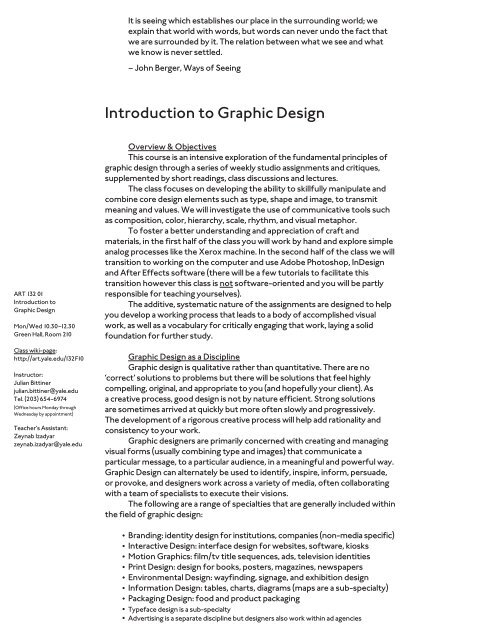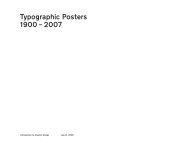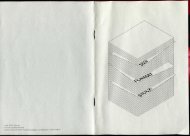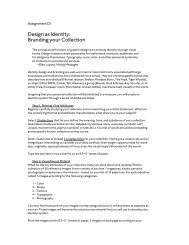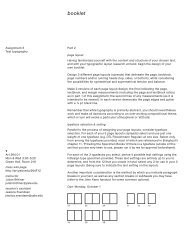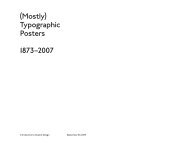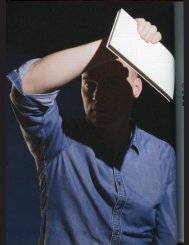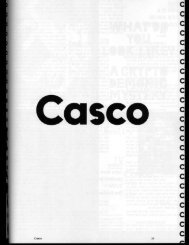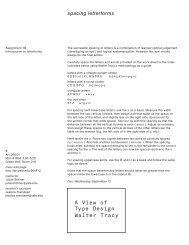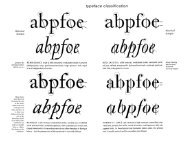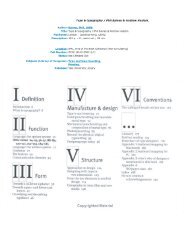Introduction to Graphic Design - Julian Bittiner
Introduction to Graphic Design - Julian Bittiner
Introduction to Graphic Design - Julian Bittiner
- No tags were found...
You also want an ePaper? Increase the reach of your titles
YUMPU automatically turns print PDFs into web optimized ePapers that Google loves.
It is seeing which establishes our place in the surrounding world; weexplain that world with words, but words can never undo the fact thatwe are surrounded by it. The relation between what we see and whatwe know is never settled.– John Berger, Ways of Seeing<strong>Introduction</strong> <strong>to</strong> <strong>Graphic</strong> <strong>Design</strong>ART 132 01<strong>Introduction</strong> <strong>to</strong><strong>Graphic</strong> <strong>Design</strong>Mon/Wed 10.30–12.30Green Hall, Room 210Class wiki-page:http://art.yale.edu/132F10Instruc<strong>to</strong>r:<strong>Julian</strong> <strong>Bittiner</strong>julian.bittiner@yale.eduTel. (203) 654-6974(Office hours Monday throughWednesday by appointment)Teacher’s Assistant:Zeynab Izadyarzeynab.izadyar@yale.eduOverview & ObjectivesThis course is an intensive exploration of the fundamental principles ofgraphic design through a series of weekly studio assignments and critiques,supplemented by short readings, class discussions and lectures.The class focuses on developing the ability <strong>to</strong> skillfully manipulate andcombine core design elements such as type, shape and image, <strong>to</strong> transmitmeaning and values. We will investigate the use of communicative <strong>to</strong>ols suchas composition, color, hierarchy, scale, rhythm, and visual metaphor.To foster a better understanding and appreciation of craft andmaterials, in the first half of the class you will work by hand and explore simpleanalog processes like the Xerox machine. In the second half of the class we willtransition <strong>to</strong> working on the computer and use Adobe Pho<strong>to</strong>shop, In<strong>Design</strong>and After Effects software (there will be a few tu<strong>to</strong>rials <strong>to</strong> facilitate thistransition however this class is not software-oriented and you will be partlyresponsible for teaching yourselves).The additive, systematic nature of the assignments are designed <strong>to</strong> helpyou develop a working process that leads <strong>to</strong> a body of accomplished visualwork, as well as a vocabulary for critically engaging that work, laying a solidfoundation for further study.<strong>Graphic</strong> <strong>Design</strong> as a Discipline<strong>Graphic</strong> design is qualitative rather than quantitative. There are no‘correct’ solutions <strong>to</strong> problems but there will be solutions that feel highlycompelling, original, and appropriate <strong>to</strong> you (and hopefully your client). Asa creative process, good design is not by nature efficient. Strong solutionsare sometimes arrived at quickly but more often slowly and progressively.The development of a rigorous creative process will help add rationality andconsistency <strong>to</strong> your work.<strong>Graphic</strong> designers are primarily concerned with creating and managingvisual forms (usually combining type and images) that communicate aparticular message, <strong>to</strong> a particular audience, in a meaningful and powerful way.<strong>Graphic</strong> <strong>Design</strong> can alternately be used <strong>to</strong> identify, inspire, inform, persuade,or provoke, and designers work across a variety of media, often collaboratingwith a team of specialists <strong>to</strong> execute their visions.The following are a range of specialties that are generally included withinthe field of graphic design:• Branding: identity design for institutions, companies (non-media specific)• Interactive <strong>Design</strong>: interface design for websites, software, kiosks• Motion <strong>Graphic</strong>s: film/tv title sequences, ads, television identities• Print <strong>Design</strong>: design for books, posters, magazines, newspapers• Environmental <strong>Design</strong>: wayfinding, signage, and exhibition design• Information <strong>Design</strong>: tables, charts, diagrams (maps are a sub-specialty)• Packaging <strong>Design</strong>: food and product packaging• Typeface design is a sub-specialty• Advertising is a separate discipline but designers also work within ad agencies


